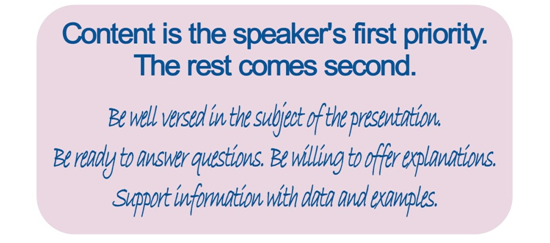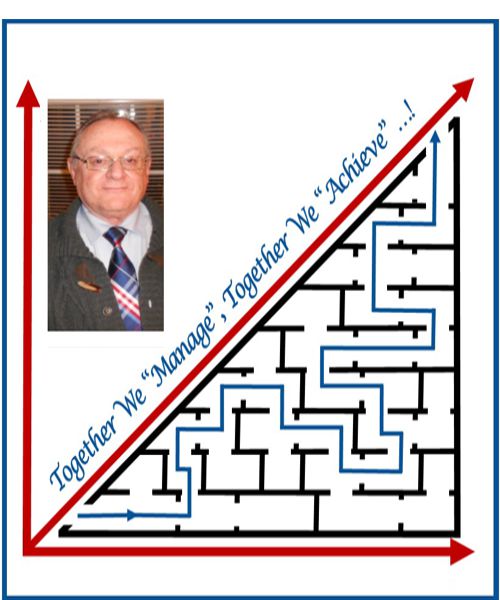Viewpoint
» On "Teaching"
» On "Learning"
» On "Knowledge"
» On "Goals"
» On "Time"
» On “Management”
» On “Reading”
» On "Committees"
» On "A Place to Visit"
» On "Human Resources"
» On "Progress & Development"
» On "History"
» On "Public Speaking"
» On "Organizing"
» On "Motivation"
» On "Teams"
» On "Communication"
» On "Management Coaching"
» On "Traveling"


On "Public Speaking"
By Adel J. Helou
To be able to stand and deliver a speech or a presentation - is one of the important skills an individual must acquire in today’s business world. Therefore, a person aspiring for a better position in the business community is advised to acquire, develop, and improve the art and skill of orally addressing an audience of more than one individual (Public Speaking).
The path to making a presentation can be divided into three stages:
Stage-1: Preparation
Stage-2: Development
Stage-3: Execution
Stage-1: Preparation
This stage is divided into the following:
» Know the type of audience targeted by the presentation.
» Choose the subject/field of the presentation.
» Write-down the objective of the presentation.
» Have an idea of how much time is available for the presentation.
» Decide on the elements to mention or discuss in this presentation.
» Identify the resources needed to develop this presentation.
» Find as much literature as possible that is needed to develop the presentation.
» Choose the subject/field of the presentation.
» Write-down the objective of the presentation.
» Have an idea of how much time is available for the presentation.
» Decide on the elements to mention or discuss in this presentation.
» Identify the resources needed to develop this presentation.
» Find as much literature as possible that is needed to develop the presentation.
Stage-2: Development
This stage is made-up of the following steps:
» Collect information on each of the topics or elements of the presentation.
» Make the content as complete as possible to cover all aspects of the topic.
» Organize the information and data collected logically and in an orderly sequence.
»Develop, analyze, and expand each idea and statement in each section and subsection.
» Prepare and develop all visual aids (documents, data, tables, graphs, and pictures) that will be presented.
» Organize the visual aids to match the progression of the oral presentation.
» Check and double check information and data you collect for validity, truthfulness, and correctness; including the visual aids that will be used.
» Avoid memorizing any part of the presentation (unless it is a needed quotation).
» Using the speaker’s own vocabulary is better than memorizing a speech.
» Prepare well the opening phrase or statement.
» Work on your voice when and where needed. Know where to emphasize, where to pause, where to repeat or rephrase, the statements during the presentation.
» Decide on the attire and clothes to wear for the presentation.
» Practice makes perfect (with voice - speak out loud):
» Make the content as complete as possible to cover all aspects of the topic.
» Organize the information and data collected logically and in an orderly sequence.
»Develop, analyze, and expand each idea and statement in each section and subsection.
» Prepare and develop all visual aids (documents, data, tables, graphs, and pictures) that will be presented.
» Organize the visual aids to match the progression of the oral presentation.
» Check and double check information and data you collect for validity, truthfulness, and correctness; including the visual aids that will be used.
» Avoid memorizing any part of the presentation (unless it is a needed quotation).
» Using the speaker’s own vocabulary is better than memorizing a speech.
» Prepare well the opening phrase or statement.
» Work on your voice when and where needed. Know where to emphasize, where to pause, where to repeat or rephrase, the statements during the presentation.
» Decide on the attire and clothes to wear for the presentation.
» Practice makes perfect (with voice - speak out loud):
» Practice the presentation often in-front of a mirror.
» Practice the presentation in-front of family members, or friends; if possible.
» Rehearse the final edition/revision of the presentation more than once.
» Practice the presentation in-front of family members, or friends; if possible.
» Rehearse the final edition/revision of the presentation more than once.
Stage-3: Execution
This stage is made-up of the following:
» Be confident.
» Be presentable.
» Be early for the presentation.
» Be prepared and organized.
» Greet attendees with a smile.
» Deliver the presentation. Be complete and truthful.
» Answer questions and offer explanations.
» Offer a courteous closure to the presentation, thanking the attendees.
» Be presentable.
» Be early for the presentation.
» Be prepared and organized.
» Greet attendees with a smile.
» Deliver the presentation. Be complete and truthful.
» Answer questions and offer explanations.
» Offer a courteous closure to the presentation, thanking the attendees.

Figure - 1
Additional hints – lest we forget:
Concentrate on the content. This is the most important part of the presentation:
» Focus on the topic and its parts and elements. Make sure to know well the material of the main topic (Figure – 1).
» Know enough information on closely related topics.
» Acquire information about topics generally related to the main topic of the presentation.
» Presenting the content in an organized and orderly manner is of paramount importance.
» Delivering the presentation well, complete, and with confidence is the key to success (Figure – 2).
» Know enough information on closely related topics.
» Acquire information about topics generally related to the main topic of the presentation.
» Presenting the content in an organized and orderly manner is of paramount importance.
» Delivering the presentation well, complete, and with confidence is the key to success (Figure – 2).

Figure - 2
Presenting oneself to the audience comes second:
» Grooming and appearance are highly considered.
» Dress in what is appropriate and acceptable for/by the audience.
» Avoid pacing across the floor in front of the audience.
» Movement of hands and arms should be controlled and not haphazard.
» Movement of hands is better kept to a minimum.
» Occasionally look at a specific person in the audience and address that person, when elaborating a point.
» Address different persons in the audience through-out the presentation.
» Avoid addressing one person for long during the presentation, unless answering a specific question asked by that person.
» The speaker should not turn the back to the audience. Writing on the white or green board must not take a long time.
» Avoid talking to the board for any extended period. The attendees like to see the speaker addressing them, not addressing the board.
» Dress in what is appropriate and acceptable for/by the audience.
» Avoid pacing across the floor in front of the audience.
» Movement of hands and arms should be controlled and not haphazard.
» Movement of hands is better kept to a minimum.
» Occasionally look at a specific person in the audience and address that person, when elaborating a point.
» Address different persons in the audience through-out the presentation.
» Avoid addressing one person for long during the presentation, unless answering a specific question asked by that person.
» The speaker should not turn the back to the audience. Writing on the white or green board must not take a long time.
» Avoid talking to the board for any extended period. The attendees like to see the speaker addressing them, not addressing the board.
Instruments and tools used during the presentation:
» Make sure that all needed tools for the presentation are available before the start of the presentation.
» Ensure that all instruments, tools, and visual aids needed are in working order. Testing should be done before of the presentation.
» Ensure that all instruments, tools, and visual aids needed are in working order. Testing should be done before of the presentation.
The venue/location of the presentation is important:
» The location of the presentation should be easy to reach by the attendees.
» There should be available parking spots for all guests and attendees.
» There should be enough space in the room for all the attendees.
» Seating arrangements should be comfortable and should allow all attendees to see the speaker and any screen or board used during the presentation.
» Attendees should be able to clearly hear the speaker from anywhere in the room.
» Any food and beverage offered must be made available ahead of time or with minimum disturbance of the presentation or the attendees.
» There should be available parking spots for all guests and attendees.
» There should be enough space in the room for all the attendees.
» Seating arrangements should be comfortable and should allow all attendees to see the speaker and any screen or board used during the presentation.
» Attendees should be able to clearly hear the speaker from anywhere in the room.
» Any food and beverage offered must be made available ahead of time or with minimum disturbance of the presentation or the attendees.
The above pointers and hints are but a few that should assist any public speaker to succeed in delivering a speech or a presentation.
Adel J Helou: is a Business and Life Management Coach. He has more than 15 years of experience in production and operations management. The Author has international professional experience in the Middle East markets. He holds a B.Sc. degree in Chemistry and Physics and an M.Sc. in Chemical Engineering. Mr. Helou has pages on Facebook, LinkedIn, Twitter, and Instagram:
facebook.com/AdelJosephHelouManagementCoach/
linkedin.com/in/adeljosephheloumanagementcoach/
Instagram.com/adel.helou
twitter.com/helou_adel
Read about his Management Coaching and the articles he writes, by visiting the electronic magazine (E-Zine): optimanage.com.
The E-Zine has a fb page: facebook.com/optimanagedotcom/.
A.J. Helou can be contacted by e-mail: a.j.helou@optimanage.com (e-mail)
linkedin.com/in/adeljosephheloumanagementcoach/
Instagram.com/adel.helou
twitter.com/helou_adel
Read about his Management Coaching and the articles he writes, by visiting the electronic magazine (E-Zine): optimanage.com.
The E-Zine has a fb page: facebook.com/optimanagedotcom/.
A.J. Helou can be contacted by e-mail: a.j.helou@optimanage.com (e-mail)




